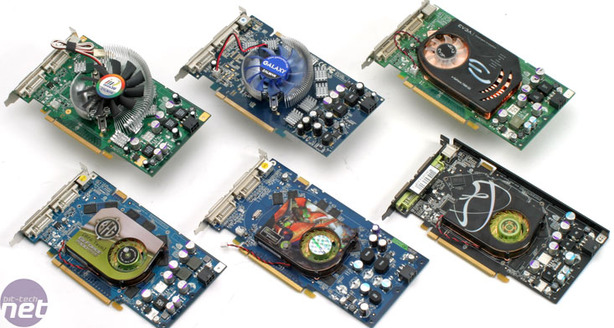GeForce 7900 GS Group Test
September 21, 2006 | 11:03

The ATI situation...
Incredibly, the supply of ATI's Radeon X1800GTO has completely dried up over the last five to seven days. There was stock a week ago, and now the product is nowhere to be seen; maybe ATI has discontinued the product? It was priced similarly to the prices that ATI's partners seem to be hitting with Radeon X1900GT, so I guess that it makes sense to make room for a better performing part at the same price point.However, what doesn't make sense is that ATI has changed the specifications on its Radeon X1900GT, seemingly without bothering to officially announce the changes to the press. Instead of the 575/1200MHz clock speeds that the original Radeon X1900GT runs at, the new Radeon X1900GT is clocked at 512/1315MHz. Speaking to ATI, company representatives claim that the performance characteristics are exactly the same, even though there is a change in clock speed. Without actually testing the two cards side by side, it is impossible to verify this claim.
Whatever the case, changing the clocks when a card has been on the market for more than four months is absolutely ludicrous - all that it is going to do is create even more confusion in an already confused market place. Looking around, we were able to find Radeon X1900GT's with the two different clock speed specifications in the same store. If the pricing on ATI's Radeon X1900GT wasn't confused enough as it is, things are just going to get even worse now in my opinion. Retailers in the UK are selling Radeon X1900GT's for anywhere between £135 and £235 - that kind of differential in price is nothing short of crazy.
Admittedly, NVIDIA's partners have been changing clock speeds for some time now, but never have I seen a manufacturer reduce the core clock and increase the memory clock in order to attain the same performance. One good thing is that with the lower core clocks, the new Radeon X1900GT should consume less power and make for a more energy efficient product. It should also help to reduce the noise that the original Radeon X1900GT's heatsink produced, too.

Rounding things up:
Simply put, GeForce 7900 GS is a breath of fresh air in the middle of NVIDIA's product lineup. Price and performance are very respectable and there appears to be an awful lot of headroom when it comes to overclocking. The pre-overclocked cards are either a match for ATI's Radeon X1900GT or they are faster, depending on how aggressive each board partner is with its shipping clock speeds. Providing both Galaxy and BFG Tech can supply the cards clocked with a 540MHz core in reasonable quantity, they're a good match for the Radeon X1900GT at a very similar price.One thing that has bugged me ever since NVIDIA officially talked to us about GeForce 7900 GS for the first time was why the company made HDCP an optional extra. I don't really need to get into why the whole next-generation content protection is a complete mess up at this point in time (that's worth saving for its own editorial), but I was surprised to see NVIDIA not pushing HDCP and its PureVideo HD platform into the mid range across every GeForce 7900 GS part made by its board partners.
Out of the six cards we have here, only EVGA has stepped up to the table and implemented HDCP on the model we have here. However, EVGA also sells another four GeForce 7900 GS products of which only one has HDCP support. The other three products in the lineup just seem redundant, especially when the crypto-ROM appears to add a mere $5-10 to the MSRP (depending on the clocks) on EVGA's home page.
We have spoken to the other board partners and it seems that they were unwilling to implement HDCP on these cards at an additional cost because the specifications for the whole hardware implemented content protection era is not really finalised at the moment. Considering Vista is just around the corner, and the fact that HD DVD and Blu-ray drives should be on the market very soon, it seems strange for new video cards not to come with the HDCP crypto-ROM chip.
For those that aren't bothered about being ready for HDCP, because they're not planning to use their computer to play back High-Definition media this probably isn't much of an issue - it seems that this is the market that most of the board partners are looking to capture. Unfortunately, there isn't a great deal of educating going on when it comes to next-generation video content because the industry itself isn't quite sure on how and what it is going to protect from piracy. Because of this, there's a lot of confusion in the market and many end users don't want to spend that extra bit of money to get a video card that is future proofed, if there is such a thing.
Final Thoughts...
The cards from BFG Tech, Galaxy, Inno3D, Point Of View and XFX are not particularly bad products in any way. In fact, had one or more of them gone ahead and pushed to implement HDCP on their GeForce 7900 GS products, we're sure that the story would have turned out a little differently. With the HD era rapidly approaching though, we think it is about time board partners started gearing up for it too.However, if you are not really concerned about HDCP compatibility and are just looking for a well-priced video card with lots of performance, we have to commend Galaxy for stepping outside of the box and making the fastest GeForce 7900 GS on test here. The inclusion of 1.2ns memory and a super-silent Zalman cooler is just the icing on the cake for that card; it's just a shame that there was no HDCP crypto-ROM included.
EVGA's card represents the best purchase for a number of reasons - the fact that the card is future-proofed when it comes to next-generation content protection methods is a definite plus point and one that should be given some serious consideration. If you're even remotely considering using your PC to play next-generation HD content, you're going to need a system that is HDCP capable.
There is also the fact that DirectX10 is just around the corner, and every man and his dog seems to want to wait for it to arrive. However, it's worth remembering that NVIDIA's release schedules are typically staggered, meaning that we may not see mid-range DirectX10 parts as soon as some are expecting.
With that in mind, EVGA's 90-day Step-Up programme may be an attractive proposition, but it may not be as attractive as it first sounded when you take into account that GeForce 7900 GS is ultimately a mid-range part. If you're looking to use EVGA's Step-Up programme to make the jump to DirectX10, we think that it would be better served with something like the recently-released GeForce 7950 GT or higher, as you're going to have to spend less money when it actually comes to making the jump to DirectX10 class hardware.
The only thing that lets EVGA's e-GeForce 7900 GS KO Superclock down is the fact that we were unable to find it in stores at the time of writing. The good news is that there appears to be stock available in the US, so it can't be long before we start seeing it appearing at e-tailers in the UK. Based on the difference in price between EVGA's products in the US, we are expecting its e-GeForce 7900 GS KO Superclock to retail for about £150 when it does start showing some signs of availability.
There are some other GeForce 7900 GS cards that we wanted to look at, but unfortunately, we couldn't get the hardware in time to be included in this roundup. With that said, we should have some more GeForce 7900 GS action next week. Stay tuned.

EVGA e-GeForce 7900 GS KO Superclock

MSI MPG Velox 100R Chassis Review
October 14 2021 | 15:04







Want to comment? Please log in.